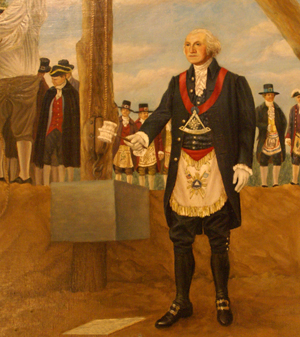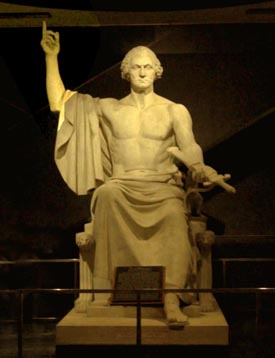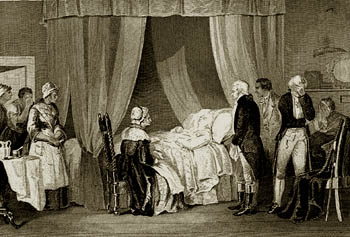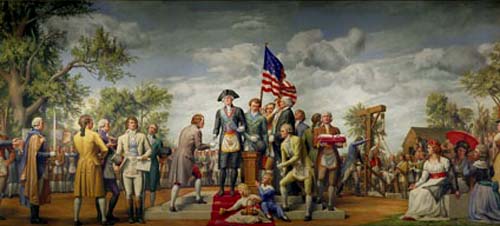 |
American History
Did George Washington Convert to Catholicism?
Marian T. Horvat, Ph.D.
An article by Ben Emerson has been making the rounds on the Internet lately. It claims that on his deathbed George Washington called for a Jesuit priest, Fr. Leonard Neale, from St. Mary’s Mission across the Piscataway River. Then Washington, who had supposedly “been an Episcopalian,” was baptized into the Roman Catholic Church. Emerson’s article alleges, but provides no evidence, that “after Washington’s death, a picture of the Blessed Virgin Mary and one of St. John were found among the effects on an inventory of articles at his home.”

Hattie Burdette's portrait of Washington in his Masonic apron |
The article also asserts the General used to make the Sign of the Cross before meals, based on the undocumented testament of his servant Juba. We are also told that “he slipped into a Catholic Church several times to attend Mass” – again, no proof or even testimony.
Another amazing unproven fact ends the piece: Washington was “a student of the writings on political philosophy of St. Robert Bellarmine and St. Thomas Aquinas.” Together with Thomas Jefferson, he incorporated into the Constitution in 1787 some of the Saints' ideas in setting up the U.S. Republic. An incredible statement - indeed, all the more so as it comes to us without the indispensable evidence.
Did George Washington really convert and die a Roman Catholic?
Washington became a focal point in American history, and it is no wonder that some Catholics want to say that he converted. One can legitimately respect some of Washington’s characteristics, such as his upright character, his admiration for the aristocracy, and his military courage. However, such partial admiration should not lead one to deny the known historical facts and accept the myth that Washington secretly adhered to the Holy Faith and died a Catholic. There is simply no solid evidence for such claims. If an affirmation like this were to appear in any serious scholarly article, it would be called fraudulent and the whole work would lose its credibility.
While Washington and his family belonged to the Church of England, very early in life he seems to have begun that reduction of religion to a vague morality, like so many men whose careers prospered in the Age of the Enlightenment. Washington was not a scholar – his formal education extended only to grammar school. It is doubtful he ever read St. Thomas Aquinas or St. Robert Bellarmine – which at that time would have been available only in Latin, a language he did not read well.
Washington was, however, ambitious. His knowledge of surveying and excellence in practical mathematics won him the favor of Lord Fairfax of Virginia, and the door to the “Old Society” opened to the gangling “country boy” ready to learn the ways of polite company. Not by coincidence, it was at this period - when his star began to rise - that George Washington was initiated into the Fredericksburg Lodge (Virginia) in 1752, and one year later was raised to Master Mason. In 1788 he was made Charter Master of the Alexandria Lodge No. 22 of Virginia. These are documented facts. (Check evidence here)

A mural in George Washington Masonic Memorial shows him in full Masonic attire laying the cornerstone of the US Capitol in 1793 |
It is also uncontested that President George Washington, dressed in Masonic attire, led a procession of Masonic officers and brethren to the site in the District of Columbia for the laying of the U.S. Capitol's cornerstone in 1793. The apron and sash worn by George Washington together with the trowel he used are today preserved in the Alexandria Washington Masonic Lodge. He remained a member and patron of “The Craft” – as Freemasonry is also called – his entire life, and 100 years after his death, the George Washington Masonic Memorial was built to commemorate him.
In his letters and addresses to Masonic bodies, Washington professed his profound esteem for their principles. In 1797, two years before his death, he addressed the Grand Lodge of Massachusetts with these words: "My attachment to the Society of which we are all members will dispose me always to contribute my best endeavors to promote the honor and prosperity of the Craft." Later in the same speech, he said that the Masonic institution was one whose liberal principles are founded on the immutable laws of truth and justice and whose grand object is to promote the happiness of the human race.
Only 13 months before his death, he declared to the Grand Lodge of Maryland, "So far as I am acquainted with the doctrines and principles of Freemasonry, I conceive them to be founded in benevolence, and to be exercised only for the good of mankind. I cannot, therefore, upon this ground, withdraw my approbation from it."
Some Catholic writers who try to “redeem” Washington claim his beliefs and behavior were actually based on the Stoic philosophy because of his self-admitted admiration for the Roman Emperor Marcus Aurelius. However, anyone who considers the pagan “virtues” promoted by Freemasonry – the quest for wisdom, peace, toleration, perseverance and self-control – will note the similarity with tenets of Stoicism.

The 12 ton statue of Washington in a Roman toga expresses his admiration for the pagan philosophy |
According to the Stoic philosophy, what counts is a man’s behavior, not his ideas. Before any situation of life the wise man - the model for the Stoic - was always calm and tolerant, refusing to show any emotion, which would distort his judgment. This would be the perfect man who lives according to Nature. To this fundamental religious indifferentism and moral tolerance of Stoicism, Freemasonry added a Deist principle - the Great Architect of the Universe or Eternal Reason - that would give a vague religious sense to the pagan way of life.
The two philosophies are very similar, and Masonry assumed part of Stoicism as its own. Therefore, when one asserts that Washington was a follower of Stoicism, he is in part correct. But he is also trying to make us swallow Masonry under the appearance of Stoicism.
Washington, like his more articulate contemporary and fellow-Freemason Jefferson, summarily rejected what they called “dogmaticism.” Like Jefferson, he was a Deist, a man who follows no particular religion but only acknowledges the existence of an impersonal God, without any articles of faith. He often spoke and wrote of the need to submit to the decrees of Providence. In Washington’s public addresses, he used the word Providence, not God. In his correspondence with the Masonic Lodges, he habitually refers to the Great Architect of the Universe. But nowhere does he mention Jesus Christ.
Washington appears to have died as he lived – faithful to his Masonic principles. His death is minutely described in the personal journal of Tobias Lear, his personal secretary for many years. He took no special leave of his family; he remained calm and without emotion, resigned to death - as any Master Mason would be.
An eye-witness account
New Hampshire's Tobias Lear, former secretary to the President, was on the scene during the long slow death of Washington on December 14, 1799 at Mount Vernon. His carefully written account offers a detailed view of Washington's last moments. It is interesting to notice that nowhere does the fanciful fabrication of Ben Emerson enter this description. Here are Lear’s words:
Doctor Dick came in about 3 o'clock, and Dr. Brown arrived soon after. Upon Dr. Dick's seeing and consulting a few minutes with Dr. Craik, he was bled again. … About half past 4 o'clock he desired me to call Mrs. Washington to his bedside, when he requested her to go down into his room, and take from his desk two wills she would find there, and bring them to him, which she did. Upon looking at them he gave her one which he observed was useless, as being suppressed by the other, and desired her to burn it, which she did.

Washington's death described in detail does not make any allusion to his conversion |
After this was done I returned to his bedside and took his hand. He said to me, "I find I am going, my breath cannot last long; I believed from the first that the disorder would prove fatal. Do you arrange & record all my late military letters & papers arrange my accounts and settle my books, as you know more about them than anyone else. Let Mr. Rawlins finish recording my other letters which he has begun." I told him this would be done. …
About 5 o'clock Dr. Craik came again into the Room & upon going to the bedside, the General said to him, "Doctor, I die hard; but I am not afraid to go, I believed from my first attack, that I should not survive it; my breath cannot last long. The Doctor pressed his hand but did not utter a word. He retired from the bed side & sat by the fire absorbed in grief.
Between 5 & 6 o'clock Dr. Dick & Dr. Brown came into the room, and with Dr. Craik went to the bed; when Dr Craik asked him if he could sit up in bed. He held out his hand & I raised him up. He then said to the Physicians, "I feel myself going, I thank you for your attentions; but I pray you take no more trouble about me, let me go off quietly; I cannot last long."
They found that all which had been done was without effect; he laid down again, and all retired, excepting Dr. Craik. He continued in the same situation, uneasy & restless; but without complaining; frequently asking what hour it was. When I helped him move at this time he did not speak; but looked at me with strong expressions of gratitude.
About 8 o'clock the Physicians came again into the room & applied blisters and cataplasms of wheat bran to his legs & feet; after which they went out (except for Dr. Craik) without a ray of hope. …
About 10 o'clock he made several efforts to speak to me before he could affect it, at length he said, "I am just going! Have me decently buried; and do not let my body to be put into the vault less than three days after I am dead. " I bowed assent, for I could not speak. He then looked at me again and said, "Do you understand me?" I replied Yes! " 'Tis well!" said he.
About 10 minutes before he expired (which was between 10 & 11 o'clock) he breating [sic] became easier; he lay quietly; he withdrew his hand from mine, and felt his own pulse. I saw his countenance changed I spoke to Dr. Craik who sat by the fire; he came to the bed side. The General's hand fell from his wrist I took it in mine and put it into my bosom. Dr. Craik put his hand over his Eyes and he expired without a struggle or sigh.

Washington laying the cornerstone of the National Capitol
Another painting at George Washington Masonic National Memorial
|
Sources:
- D’Elia, Donald, The Spirit of ’76: A Catholic Inquiry (Christendom Publications:1983), pp. 72-85.
- Bowler, Paul, “George Washington and Religion Liberty, in James M. Smith, etc., George Washington: A Profile (NY: Hill and Wang 1969)
- George W. Nordham, The Age of Washington, Chicago: Adams Press, 1989
- George Washington Papers online, Library of Congress
- George Washington Masonic Memorial
- Bessel, Paul M., George Washington's Writings About Freemasonry and Attendance at Masonic Meetings and Events
- Henriques, Peter R. The Death of George Washington: He Died as He Lived, Mt. Vernon, VA: The Mount Vernon Ladies' Association, 2000

Posted January 27, 2009

Related Topics of Interest
 Catholicism in Colonial America Catholicism in Colonial America
 La Conquistadora: Our Country's Oldest Madonna La Conquistadora: Our Country's Oldest Madonna
 Ven. Antonio Margil of Jesus: Apostle of New Spain and Texas Ven. Antonio Margil of Jesus: Apostle of New Spain and Texas
 Refuting the False Statements about Life in the Middle Ages Refuting the False Statements about Life in the Middle Ages
 Defending the Crusades Defending the Crusades
 The Swan's Song of Galileo's Myth The Swan's Song of Galileo's Myth

Related Works of Interest
|
|
History | Home | Books | CDs | Search | Contact Us | Donate

© 2002-
Tradition in Action, Inc. All Rights Reserved
|
 |
|